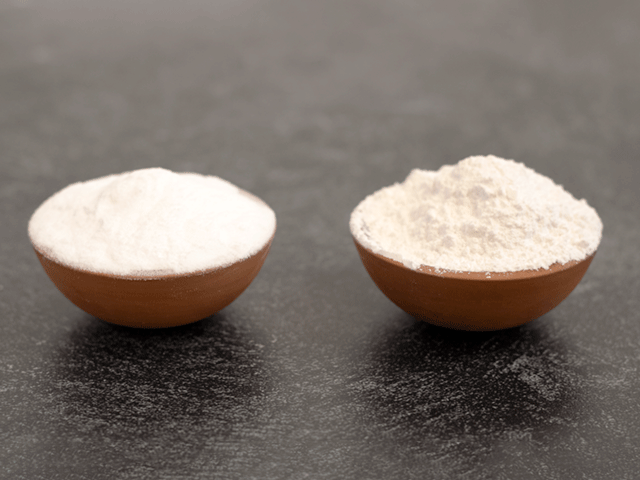
I love making quick breads. They’re so versatile. Have too much zucchini? Pop it in a quick bread. Craving something sweet? Make an almond joy coconut quick bread. Short on time and need some toast? Go for a savory sourdough discard quick bread.
But even though quick breads are diverse in their flavors, they all share two common ingredients: baking powder or baking soda as leavening agents. Some recipes even call for both.
Baking soda and baking powder are essential for lifting quick breads in the oven. They give breads their fluffy, porous texture. But should you use baking powder or baking soda for your next recipe? Are they interchangeable? Let’s take a look at the difference between the two and how they affect your quick bread.
A Closer Look at Baking Soda
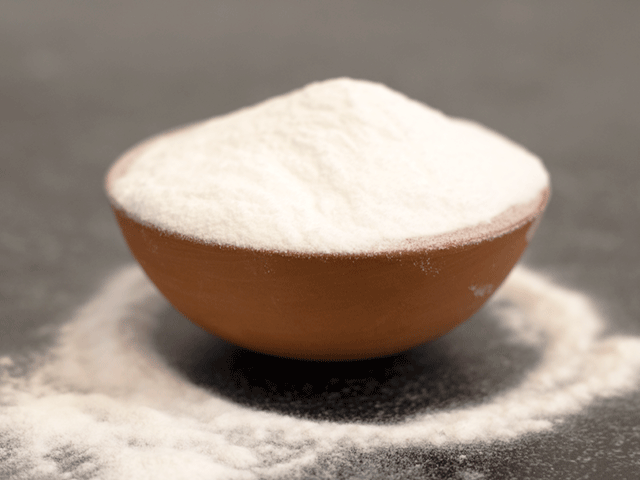
Baking soda is the common name for the chemical leavener sodium bicarbonate. It has a variety of uses from cleaning clothes to easing heartburn to treating bug bites. When combined with an acidic ingredient, baking soda produces a lot of carbon dioxide gas bubbles.
If you add baking soda to a quick bread, the gas bubbles it releases into the batter lifts your bread. When the combination of baking soda and acid combines with heat, proteins in the batter (like eggs) turn rigid. The rigid structure traps the gas and results in a light, fluffy texture. This reaction happens fast and weakens over time. As a result, you should only mix your baking soda into your batter right before you put your bread in the oven.
Baking soda is about 3 to 4 times stronger than baking powder, but only when combined with an acidic ingredient. Without an acid to neutralize, leftover baking soda in your bread will taste metallic and soapy. Consequently, baking soda works best in recipes that use acidic ingredients such as buttermilk, yogurt, lemon juice, cream of tartar, or vinegar.
Not sure how much baking soda to add to your recipes? As a general rule, aim for 1/4 teaspoon of baking soda for every 1 cup of flour.
A Closer Look at Baking Powder

Baking powder uses baking soda has its key ingredient. Many baking powder brands combine sodium bicarbonate with an acidic component (such as cream of tartar) and a starch component (such as cornstarch).
As with baking soda, baking powder also releases gas bubbles into your quick bread, giving it a softer, fluffier texture in the oven. But because baking powder already has an acid to react with, you don’t need to worry about including molasses, cocoa powder, applesauce, or honey to your quick bread recipe to ensure a proper rise.
Not sure how much baking soda to add to your recipes? As a general rule, aim for 1 teaspoon of baking soda for every 1 cup of flour.
What About Double-Acting Baking Powder?
In the past, stores sold two types of baking powder: single acting and double acting. However, double-acting baking powder has long since replaced single-acting products, and you won’t likely find single-acting baking powder on the shelves anymore.
Essentially, double-acting baking powder has two reactions that produce gas. The first reaction occurs whenever dry baking powder combines with a wet ingredient. To maximize the lifting that occurs during this first reaction, you need to add baking powder at the end of your mixing stage and quickly finish your bread.
The second reaction that produces gas occurs when baking powder has access to moisture and heat. Consequently, your bread will still rise in the oven even if you don’t fully capitalize on that first reaction.
Can You Substitute One for the Other?
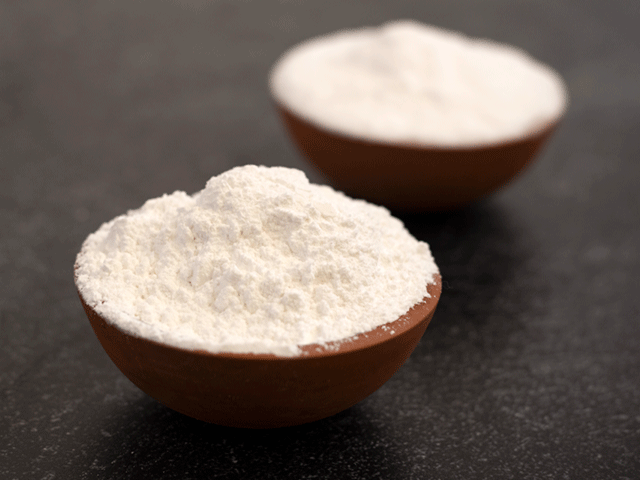
If you’ve run out of baking powder or baking soda, you could potentially substitute one for the other. However, they are not equal in strength or behave exactly the same, so you’ll have to exercise a bit of caution. Do not assume they are interchangeable.
Using Baking Powder Instead of Baking Soda?
For every teaspoon of baking soda in a recipe, triple the amount of baking powder you use.
- 1 Teaspoon of Baking Soda = 1 Tablespoon Baking Powder.
And because baking powder has quite a bit of sodium, you’ll need to cut the salt in your recipe by half.
Using Baking Soda Instead of Baking Powder?
You can make your own baking powder if you have baking soda, cream of tartar, and cornstarch.
- 1 Teaspoon Baking Powder = 1/4 Teaspoon Baking Soda + 1/2 Teaspoon Cream of Tartar + 1/4 Teaspoon Cornstarch
Don’t have cream of tartar? You can still make a baking powder substitute so long as you have an acidic ingredient.
- 1 Teaspoon Baking Powder = 1/4 Teaspoon Baking Soda +1 Teaspoon White Vinegar (or 1 Teaspoon of Lemon Juice)
Keep in mind that white vinegar or lemon juice can affect the flavor of your food, so you may need an extra tablespoon or two of sugar to compensate.
Why Use Both Baking Soda and Baking Powder?
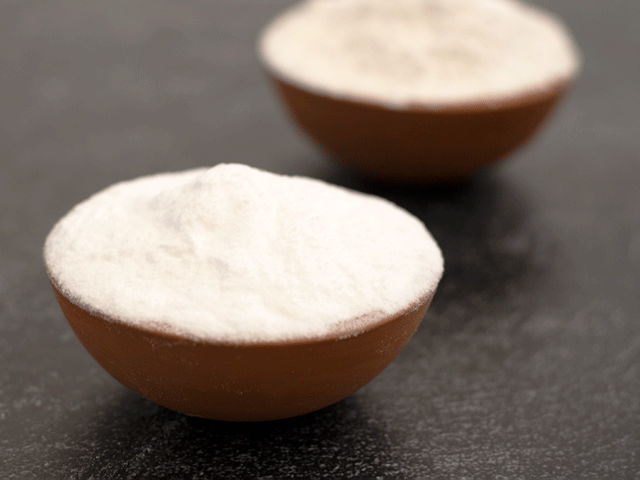
Quite a few quick bread recipes recommend using either baking powder or baking soda. Understandably, recipes that lack an acidic ingredient would likely need baking powder to give it proper lift. But what about recipes that use both?
It’s all about a balance of flavor and texture.
For illustrative purposes, let’s say you’re making a butter pecan quick bread.
Why Not Baking Soda on Its Own
The example recipe features buttermilk to lend the loaf a tangy flavor. Since buttermilk is acidic, baking soda seems like the obvious choice for your bread. But when you combine baking soda with an acid, the baking soda neutralizes the acid while it creates carbon gas. As a result, the buttermilk won’t taste quite as tangy.
Furthermore, baking soda works fast, but it lose its strength after a while. When making cookies, the fast action from the baking soda wouldn’t be a problem. In contrast, when making a quick bread that bakes in the oven for almost an hour, baking soda on its own won’t be enough to keep your bread from sinking in the middle.
Why Not Baking Powder on Its Own
So why not use baking powder on its own? If you want that lingering tang from the buttermilk and a delayed reaction to give the bread staying power in the oven, baking powder seems like the solution, right?
Unfortunately, baking powder is not as effective as baking soda. In the formula above, you need at least 3 times as much baking powder to get the same lifting effect as baking soda. The more baking powder you add, the less salt your recipe will need. Even if you cut the salt entirely from your recipe, the amount of baking powder you need to adequately lift your bread might still leave your loaf tasting bitter.
By mixing baking soda with baking powder, you can lift your quick bread without completely eliminating the subtle buttermilk tang.
Can You Mix Them With Yeast?
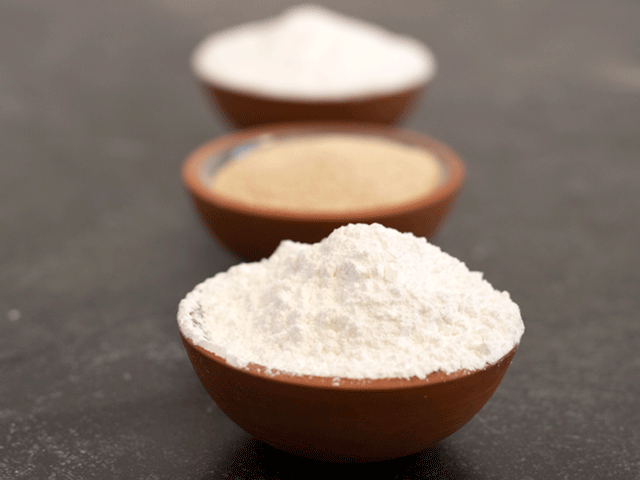
Yeast is another lifting ingredient for bread, so why don’t recipes often combine yeast with baking powder or baking soda? The more carbon dioxide gas you have, the fluffier your quick bread, right?
Both baking soda and baking powder rely on chemical reactions to lift your bread. Yeast, however, consists of living organisms that consume sugars and starches and then excrete carbon dioxide. While sodium bicarbonate’s effect is almost instantaneous, yeast requires a lot more time to achieve a similar effect.
Think of baking soda and baking powder as sprinters while yeast is a long-distance marathoner. When you combine baking powder or baking soda with yeast, the sodium bicarbonate will fizzle out while the yeast is just getting started.
It is possible to mix them, however. In my savory sourdough discard quick bread recipe, I use a combination of baking powder and sourdough starter (which has a lot of wild yeast). But the yeast in this recipe only contributes to flavor, not to lifting.
Want to Learn More?
I hope this post answers your questions about whether you should use baking powder or baking soda in your quick bread recipes. But if you want to know more, don’t hesitate to ask a question in the comment section below. I love learning more about baking, and I’d be happy to work with you to find the answer.

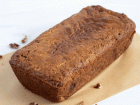
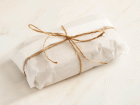
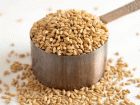
Thanks for this post, it is super informative! I often make muffins and pancakes with my sourdough discard that is sometimes quite sour. Do you have any tips for figuring out how much baking soda and/or baking powder to use if I want the flavor to be less acidic but also want to avoid the metallic taste? I usually stick with just baking soda, but sometimes don’t get the lift I want or end up with too
much of the metallic taste.
Hey Julia, thank you so much for your comment. I wish I could give you more specifics, but that’s a question I’m still trying to answer in my own baking and it varies quite a bit depending on the recipe. In sweet recipes like muffins, sometimes a bit of sugar and cinnamon work best to offset the sourness. But if you’re trying to keep sugar minimal, you might also take a look at your discard – recently fed discard won’t be as sour as discard that has sat in the fridge all week. Sometimes I also compare several similar recipes and do a taste test and see which recipe has the amount of sour flavor that I enjoy and try to incorporate those proportions of baking soda/powder to see what works. If you want, check out some of my favorite sourdough discard recipes and see if any of those help you.